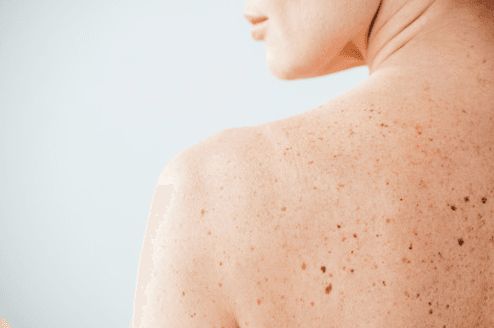
Moles are very common for people to develop and they can be visible on the skin as early as birth. People with light skin tend to have more moles than other people, and the American Academy of Dermatology suggests that anywhere from 10-40 moles on the skin is normal. Although moles are usually harmless, they still should be monitored and checked by a medical professional occasionally. They have the potential of turning into melanoma, but can also be treated effectively if melanoma is caught in the early stages. We’ve provided you with some facts on moles and how you can take care of them or remove them with a laser treatment or other methods if needed.
How Common Are Moles And Red Moles?
Moles are simply defined as an overgrowth of the body’s skin cells referred to as melanocytes. According to Genetics Home Reference, scientists have not conducted extensive studies on the genetics of moles since most of them are benign. However, tendencies show that mole development is inherited since multiple generations of a family may have a similar number of them. New moles can develop over time, especially during adolescence as hormone levels change. Sun exposure is a known factor of mole development as well on areas of the skin exposed to the sun most often.
Red moles are also common even though they may look worrisome when you first see them show up on your skin. These are also referred to as cherry angiomas and are harmless. They appear as a result of small red blood vessels and are typically found on a person’s back. Even though they aren’t dangerous, many people seek cherry angioma removal treatments since they can be irritating and unattractive to look at.
Some Moles May Be Present At Birth
A newborn baby can have a few moles on their body right when they are born or shortly afterward. These are usually very small, but in rare cases, a large mole may be present. The small moles typically are not a cause for concern, but your medical professional may want you to get any large moles checked out by a dermatologist since they are at a higher risk of melanoma development. Whether your baby has moles right when they are born or slowly develops them throughout their childhood, it’s always important to have them examined occasionally to catch potential melanoma as early as possible.
The Appearance Of Moles Can Change Over Time
Some of your moles may stay the same throughout your life, but others may change significantly. They could get larger, smaller, darker, grow hair from them, change shape and even disappear. The ones you need to be concerned about are the ones that get excessively large or become irregularly-shaped. Those types of changes may be harmless, but they could also signify early melanoma development. Annual checkups with your dermatologist can help you monitor them closely and to give you peace of mind that the changes in the appearance of your moles are harmless or can be treated quickly and safely.
Do Numerous Moles Increase The Risk Of Melanoma Development?
Research is still ongoing regarding the susceptibility of melanoma development as it relates to moles. However, trends indicate people with a large number of moles are typically at a higher risk of developing melanoma. Moles that are exposed to the sun are at a higher risk of melanoma development than those that are covered up most of the time. But it’s still possible for a mole not exposed to the sun to develop melanoma and people with only a few moles can develop it as well.
Some Moles Can Be Removed With Laser Therapy
Dermatologists can often cut out moles from your skin if they believe they could present a risk of melanoma development. Small moles may be removed with a laser treatment if they are confirmed to be non-cancerous. The laser treatment involves sending a light beam through the skin to create tiny columns, which are then pushed out naturally and replaced with new and fresh skin. Not all moles can be removed with laser therapy, though, so it’s important to work with your dermatologist and a certified laser technician for the best treatment option.
On the other hand, cherry angiomas can safely be removed with a laser treatment since they are at a much lower risk of being harmful. And the best part about cherry angioma removal with laser therapy is it usually takes a single treatment to remove it. Your medical professional may suggest multiple treatments if you have numerous red moles around your body, but it is possible to have them all treated at once.
How To Care For And Protect Your Moles
Moles typically don’t need any special treatments to keep them safe, but you just need to be conscious of them. If you have moles on your arms, face, neck or other areas frequently exposed to the sun, wear protective gear or sunscreen to reduce the direct exposure. Everything that you do for normal sun protection should be sufficient for protecting your moles as well. However, after being exposed to the sun for an extended amount of time, take a close look at any exposed moles and look for any color differences or if they feel any different. There’s never any harm in getting them checked out by your medical professional to have peace of mind.
Skin Deep Laser Services offers cherry angioma removal and we may also be able to remove small, non-cancerous moles using laser therapy. We will start with an initial consultation to evaluate your skin and moles and discuss your medical history. At that point, we can suggest treatment options to you and confirm whether a laser treatment would be beneficial for you. Our goal is to make every client as comfortable and confident as possible when working with us, so contact us today to get started with a free consultation.


